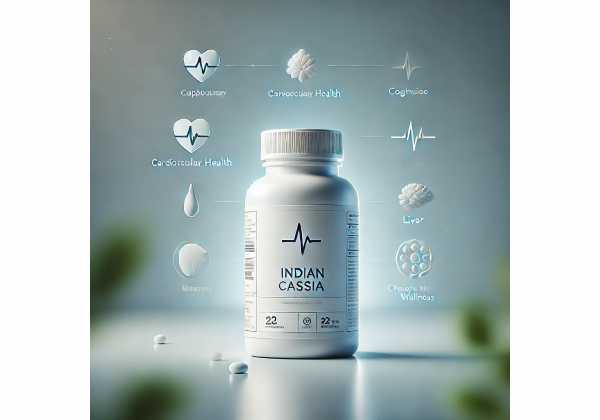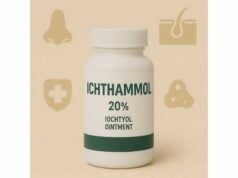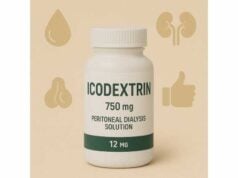
Indian cassia is the warming, sweet-spicy cinnamon most cooks meet first—the sturdy “cassia” bark used in chai, biryani, and bakery spice blends. In nutrition and herbal practice, “Indian cassia” typically refers to cassia-type cinnamon (from Cinnamomum species such as C. cassia and C. burmannii) grown or traded in the Indian subcontinent. Some markets also use “Indian cassia” historically for tejpat/tejpatta (Cinnamomum tamala, the Indian bay leaf), which is aromatically related but botanically and culinarily distinct. This guide clarifies the difference, then focuses on cassia-type cinnamon bark—how it may support blood sugar and metabolic markers, how to use it well, and how to stay within safe daily intakes given its natural coumarin content. You will find clear, people-first instructions on choosing forms, preparing it at home, and deciding how much to take (with practical teaspoon equivalents), plus who should avoid it and why.
Fast Facts
- Modestly lowers fasting glucose and HbA1c in adults when used consistently alongside standard care.
- Typical supplemental range: 1–6 g/day ground bark (about ½–2¾ teaspoons), taken with meals.
- Safety note: cassia cinnamon naturally contains coumarin; keep long-term intake moderate to protect the liver.
- Avoid if pregnant, if you have active liver disease, or if you use anticoagulants; discuss with a clinician if you take diabetes medications.
Table of Contents
- What is Indian cassia, exactly?
- Does Indian cassia really help blood sugar and metabolic health?
- How to use Indian cassia day to day
- How much Indian cassia per day?
- Safety, side effects, and who should avoid it
- Evidence snapshot and research gaps
What is Indian cassia, exactly?
“Indian cassia” is a trade and culinary term with two meanings you may encounter:
- Cassia-type cinnamon bark from trees in the Cinnamomum genus—most commonly Cinnamomum cassia (Chinese cassia) or C. burmannii (Indonesian cassia)—grown, processed, or traded in the Indian subcontinent. This is the rigid, thick bark that curls into sturdy single-layer quills. It smells strongly of warm cinnamon and tastes sweet-pungent with a slight bite. This article focuses on this bark because it is the form studied for metabolic benefits and most often sold as “cinnamon” powder in shops worldwide.
- Tejpat/tejpatta leaves (Cinnamomum tamala), sometimes historically labeled “Indian cassia” or “Indian cassia lignea.” These are the aromatic leaves used like bay leaves in Indian cuisines (especially in biryani, pulao, and korma). Tejpat leaves are not interchangeable with cinnamon bark in either flavor or research; they contribute a clove-like, camphoraceous note rather than the classic bakery-cinnamon sweetness. They are delicious in cooking, but they are not the subject of most supplement studies.
Key chemical distinction: Cassia-type cinnamon bark is naturally high in cinnamaldehyde (gives the classic aroma) and contains coumarin, a plant constituent that can stress the liver in high amounts. Ceylon (“true”) cinnamon (Cinnamomum verum) contains much less coumarin. Tejpat leaves have a different essential-oil profile (notably eugenol and linalool) and are used whole in stews and rice but not studied as a glucose-support supplement.
How to tell them apart at home:
- Cassia bark quills are thick, hard, and curl in a single scroll; when ground, they make the familiar “cinnamon” powder.
- Ceylon bark makes thin, papery layers that crumble easily and form many concentric rings.
- Tejpat leaves are long, olive-green leaves with three central veins; they are used whole and removed before serving.
For clarity and safety, the rest of this guide uses “Indian cassia” to mean cassia-type cinnamon bark (powder, quills, or standardized extracts) used for culinary and supplemental purposes.
Does Indian cassia really help blood sugar and metabolic health?
Short answer: Yes—modest, clinically meaningful improvements are plausible when cassia cinnamon is used consistently alongside standard diet and medication, particularly in type 2 diabetes. The strongest, most consistent signals are on fasting plasma glucose (FPG) and HbA1c (a three-month average of blood sugar), with additional support for insulin and HOMA-IR (insulin resistance). These effects tend to be small to moderate rather than dramatic, and they work best as part of a comprehensive plan—not as a replacement for medical care.
What pooled evidence shows
A large umbrella meta-analysis aggregating prior meta-analyses found that cinnamon supplementation significantly reduced fasting plasma glucose and HbA1c, with the HbA1c reduction averaging about 0.10 percentage points across high-quality syntheses. That is a subtle shift, but at the population level it is meaningful—comparable to adding another lifestyle lever (for example, another short walk after meals). Some more recent syntheses focusing on interventional trials also report improvements in insulin and HOMA-IR. Variability is high among trials (different species, doses, durations, and baselines), which explains why individual studies sometimes look “negative” while pooled estimates are positive.
What cinnamon probably does (mechanisms):
- Insulin signaling: cinnamaldehyde and polyphenols may increase insulin receptor phosphorylation and GLUT4 translocation, improving cellular glucose uptake after meals.
- Carb digestion: inhibition of α-glucosidase may slow starch breakdown, smoothing post-meal glucose spikes.
- Inflammation and oxidative stress: antioxidant activity may reduce low-grade inflammation that complicates insulin action.
- Gastric emptying/satiety: culinary doses in food and tea can modestly slow gastric emptying in some people, supporting steadier post-prandials and slightly reduced intake.
What to expect in practice
- If your baseline HbA1c is elevated (e.g., ≥7.0%), consistent daily use for 12–16 weeks may lower HbA1c by a fraction of a percent and improve fasting glucose by roughly 5–15 mg/dL.
- People with prediabetes or insulin resistance may notice smoother post-meal numbers on a continuous glucose monitor when cassia is paired with carbohydrate-rich meals.
- Benefits are additive with medication and lifestyle changes, not a substitute.
Who tends to benefit most:
- Adults with type 2 diabetes already following clinician-directed care.
- Those who respond to post-meal spices (e.g., adding ½–1 teaspoon to yogurt, oats, or tea).
- People using cinnamon with meals rather than on an empty stomach.
Who may see less impact:
- Individuals with already well-controlled HbA1c (e.g., ≤6.5%)—there is simply less room to improve.
- Short trials under 8 weeks.
- Products with very low bioactive content (old, stale spice; poorly standardized extracts).
Bottom line: Indian cassia can be a helpful, low-cost adjunct for glycemic management when used consistently, with realistic expectations and safe dosing.
How to use Indian cassia day to day
Choose your form
- Ground cassia powder (kitchen spice): easiest to use in food and drinks. Look for a “packed on” or “harvest” date; fresher spice has stronger aroma and likely more active constituents.
- Whole quills (sticks): best for simmering in tea, milk, or broths; they release flavor more slowly and store well.
- Standardized extract capsules: convenient for routine dosing; quality brands indicate the botanical (e.g., Cinnamomum cassia), plant part (bark), extract ratio (e.g., 10:1), and daily equivalent of dried bark.
Flavor-first ways to add 1–3 g/day
- Stir ½–1 tsp (about 1–2.5 g) into oatmeal, dahi/yogurt with fruit, or a protein smoothie.
- Bloom ½ tsp in ghee or oil at the start of cooking kheer, halwa, or porridge.
- Simmer 1 quill in tea (masala chai), coffee, or warm milk for 10 minutes; add cardamom or ginger to amplify digestion benefits.
- Toss ½ tsp into spice rubs for chicken or paneer, or add to dal tadka with cumin and hing for a cozy finish.
Brewing guide: cinnamon chai (gentle digestion support)
- Bring 250–300 mL water to a boil.
- Add 1 cassia quill (or ¾ tsp ground), 2–3 cardamom pods, and optional 2–3 thin ginger slices. Simmer 8–10 minutes.
- Add 150–200 mL milk of choice and 1 tsp black tea; simmer 3–4 minutes.
- Strain; sweeten lightly if desired. Drink with meals to soften post-prandial spikes.
Storage and freshness
- Keep in a sealed jar away from heat and light; aim to finish ground spice within 6–12 months.
- For quills, up to 18–24 months if dry and sealed. Older spice is safe but less potent; you may need slightly more for the same flavor—and potentially less for supplements, which are standardized by label.
Quality and safety checks
- Coumarin awareness: cassia is naturally higher in coumarin than Ceylon cinnamon. Keep long-term intakes moderate (see the dosage section for specifics).
- Contaminants: occasionally, ground cinnamon has been recalled for heavy metals (e.g., lead) or adulterants. Buy from reputable brands that publish batch testing or certifications; consider whole quills you grind yourself.
- Botanical on label: prefer products that clearly list the species (e.g., Cinnamomum cassia), plant part (bark), and extract details.
Smart combinations
- Pair with meal protein and fiber to further blunt glucose spikes.
- Combine with walking 10–15 minutes after meals for compounding benefits.
- If you use berberine, metformin, acarbose, or GLP-1s, cinnamon may complement the regimen—but see the safety section for interaction notes.
How much Indian cassia per day?
Here is a practical, safety-forward dosing framework for cassia cinnamon bark (powder, quills, or standardized extract equivalents).
Everyday culinary use (general wellness)
- 0.5–2 g/day in food or tea (about ¼–1 tsp ground), taken with meals. This fits typical culinary patterns and stays comfortably within conservative safety limits for most adults.
Adjunctive glycemic support (time-limited trial)
- 1–3 g/day ground cassia bark, divided with meals, for 8–16 weeks. Many clinical trials use 1–6 g/day; real-world practice favors the 1–3 g/day middle where benefits and tolerability balance well. If using a standardized extract, follow the label to match ~1–3 g/day bark equivalent.
Traditional digestion support
- 1–2 g per serving in warm milk or tea; or 1 quill simmered 8–10 minutes in 300 mL water/milk, up to twice daily with meals.
Teaspoon shortcuts
- ¼ tsp ≈ 0.6 g
- ½ tsp ≈ 1.2 g
- 1 tsp ≈ 2.3–2.6 g
Variation depends on grind and moisture; weigh once if you need precision.
Time of day and meal timing
- Take with carbohydrate-containing meals to align peak activity with post-prandial glucose.
- For extracts, split doses (e.g., breakfast and dinner).
Duration and evaluation
- Trial for 12 weeks, then reassess fasting glucose, post-prandials, and HbA1c (if relevant). Continue only if benefits are clear and you remain within safety limits.
Safety guardrail: coumarin awareness
Coumarin is a natural plant constituent higher in cassia than in Ceylon cinnamon. Safety agencies set a tolerable daily intake (TDI) of 0.1 mg/kg body weight/day for coumarin (e.g., 6 mg/day for 60 kg, 7 mg/day for 70 kg). Because coumarin content varies widely among cassia products, use these practical guardrails:
- Keep long-term cassia intake at or below ~1–2 g/day unless supervised.
- For short trials (8–16 weeks), 1–3 g/day is commonly used; stay on the lower end if you are light-weight, have liver considerations, or use interacting drugs.
- If you regularly consume cassia-rich foods (e.g., cinnamon-heavy desserts or spiced mixes), consider choosing Ceylon cinnamon for everyday sprinkling and reserving cassia for recipes you specifically prefer—this keeps overall coumarin exposure modest.
Who should choose Ceylon instead?
- If you plan to use >2 g/day long-term, have liver risk, are pregnant, or simply want the lowest coumarin exposure, Ceylon (“true”) cinnamon is the safer default for routine, high-frequency use.
Safety, side effects, and who should avoid it
Common, usually mild effects
- Gastrointestinal: heartburn, stomach upset, or mouth irritation—more likely with dry powder taken without food. Solution: take with meals, switch to tea or capsules, or reduce the dose.
- Allergy/irritant contact reactions: rare but reported; discontinue if rash, mouth sores, or wheeze occur.
Liver health and coumarin
- Cassia cinnamon can contribute meaningful coumarin exposure. Most healthy adults remain well under the TDI at culinary intakes, but pushing high doses or combining multiple coumarin sources (certain spice blends, teas, or supplements) can raise risk, especially in sensitive individuals.
- Warning signs: unusual fatigue, dark urine, right-upper-quadrant pain, unexplained nausea—seek medical attention and stop use.
- If you have known liver disease, choose Ceylon cinnamon for flavor and avoid cassia supplements unless your clinician agrees and monitors you.
Medication and condition interactions
- Diabetes medications (metformin, sulfonylureas, insulin, SGLT2, GLP-1): cassia can further lower glucose. Monitor for hypoglycemia when starting or increasing the dose; coordinate with your clinician for potential medication adjustments.
- Anticoagulants/antiplatelets (warfarin, DOACs, aspirin): theoretical increased bleeding risk (irritant oils plus spice-level coumarin and eugenol). Keep culinary amounts modest; avoid supplemental dosing unless your prescriber approves.
- Hepatotoxic medications (e.g., high-dose acetaminophen, certain antituberculars): be cautious with high cassia intakes.
- Allergy to cinnamon or Peru balsam: avoid.
Special populations
- Pregnancy: avoid cassia in supplemental doses; culinary use is generally considered acceptable.
- Breastfeeding: limited data—prefer culinary amounts only.
- Children: culinary use is fine; avoid supplemental dosing unless a pediatric clinician recommends and supervises it.
- Older adults or underweight individuals: start low (e.g., ¼–½ tsp/day) and assess tolerance.
Product quality and contamination
- Purchase from reputable brands that test for heavy metals and microbial contaminants. Choose products that identify the botanical species and plant part (bark).
- Be alert to recalls for adulteration or heavy metals (e.g., lead). If a product tastes atypically metallic, unusually bitter, or dusty, stop using it and check for advisories.
When to stop and seek care
- Persistent abdominal pain, jaundice, dark urine, or unusual bruising/bleeding.
- Repeated low blood sugar episodes after starting cinnamon.
- Any suspected allergic reaction.
Bottom line: culinary amounts are broadly safe for most people; supplemental doses require thoughtful use, attention to coumarin, and—if you take medications—coordination with your clinician.
Evidence snapshot and research gaps
What is strongest today
- Aggregated analyses of randomized trials show modest but significant improvements in fasting glucose, HbA1c, insulin, and HOMA-IR with cinnamon taken over weeks to months, particularly in adults with type 2 diabetes who continue standard care. Effects on lipids and blood pressure are less consistent; some meta-analyses suggest small improvements in triglycerides or LDL-C, but results vary by dose, species, and duration.
- Dose window: most human trials cluster between 1–6 g/day of ground bark equivalents (or standardized extracts), taken with meals for 8–16 weeks.
- Safety profile: generally well tolerated at these doses; the main theoretical and practical risk is excess coumarin with high-cassia diets or supplements over time. Occasional quality issues (e.g., heavy metals) underscore the value of purchasing from reputable sources.
What remains uncertain
- Species-specific effects: Many studies do not confirm whether the product was cassia or Ceylon. Because cassia is the global default, most “cinnamon” trials likely used cassia—but species confirmation would help interpret coumarin exposure and efficacy.
- Standardization: Trials vary widely in extract ratios and marker compounds; future research should standardize to defined ranges of cinnamaldehyde and polyphenols.
- Long-term outcomes: We lack long-duration trials (≥1 year) powered for clinical endpoints (e.g., microvascular or cardiovascular outcomes).
- Precision nutrition: Individual responses may differ by gut microbiome, baseline insulin resistance, meal composition, and genetics; these moderators are under-explored.
Practical takeaways for readers and clinicians
- Frame cassia cinnamon as a supportive adjunct: helpful, low-cost, low-risk when used mindfully with meals and within coumarin-aware limits.
- Start with 1 g/day and titrate to 2–3 g/day if tolerated and needed, reassessing at 12 weeks.
- If long-term daily use is desired—or if liver risk exists—switch to Ceylon for routine sprinkling and keep cassia for special recipes.
References
- Cinnamon: Usefulness and Safety | NCCIH 2024 (Guideline/Fact Sheet)
- The effect of cinnamon supplementation on glycemic control in patients with type 2 diabetes or with polycystic ovary syndrome: an umbrella meta-analysis on interventional meta-analyses 2023 (Systematic Review)
- Cassia – Cinnamomum aromaticum (Natural Health Products Monograph) 2025 (Guideline/Monograph)
- Survey on the consumption of cinnamon-containing foods and drinks | Food Standards Agency 2015 (Government Report)
- FDA Alert Concerning Certain Cinnamon Products Due to Presence of Elevated Levels of Lead 2024 (Government Advisory)
Medical Disclaimer
This article is for educational purposes and does not replace personalized medical advice, diagnosis, or treatment. Cinnamon and other supplements can interact with medications and health conditions. Do not start, stop, or change any treatment based on this information without talking to your qualified health professional. If you are pregnant or breastfeeding, have liver disease, or manage diabetes or bleeding disorders, seek individualized guidance before using cassia cinnamon in supplemental amounts.
If you found this helpful, consider sharing it on Facebook or X (formerly Twitter), or any platform you prefer. Your support helps us keep creating clear, trustworthy health guides—thank you for reading and sharing.










